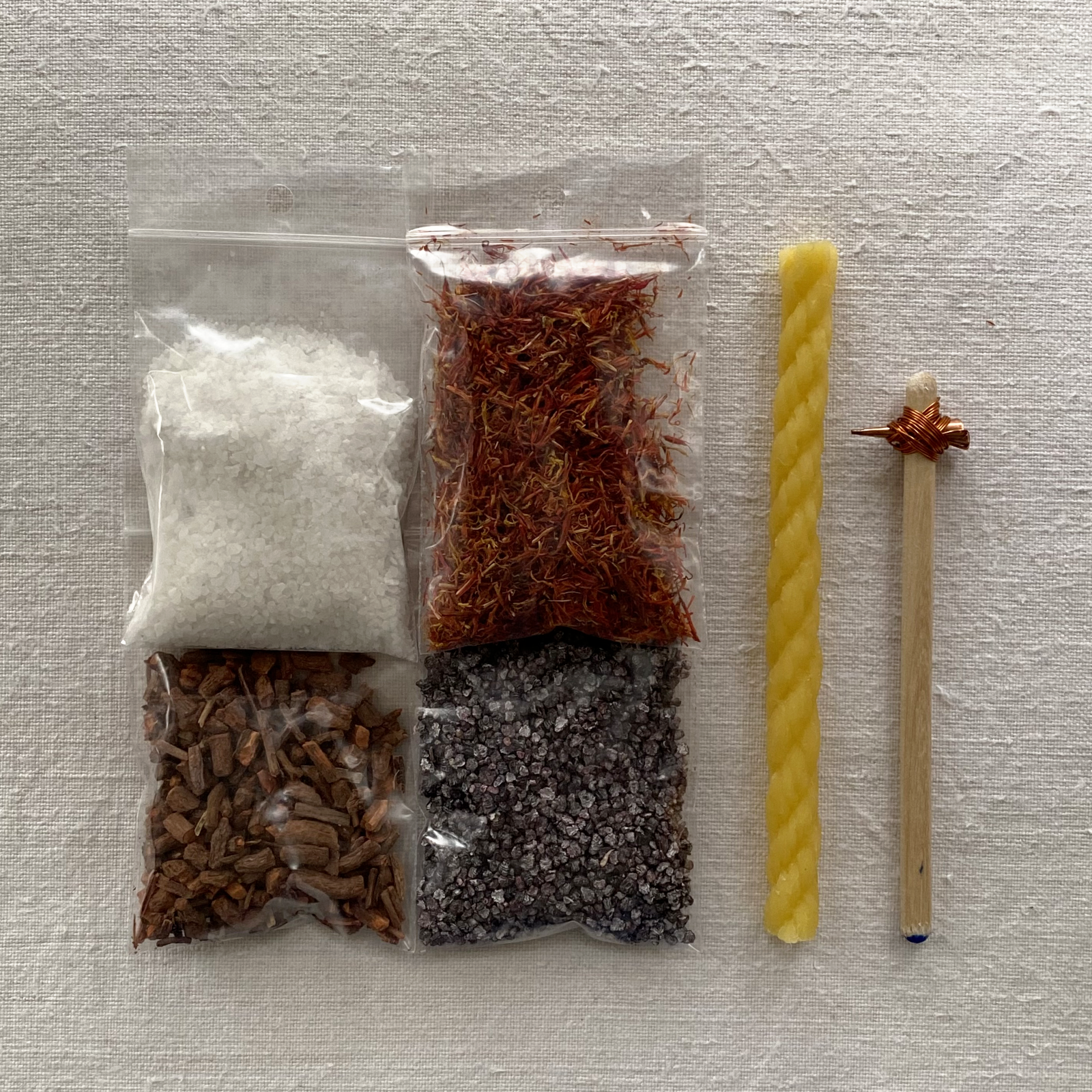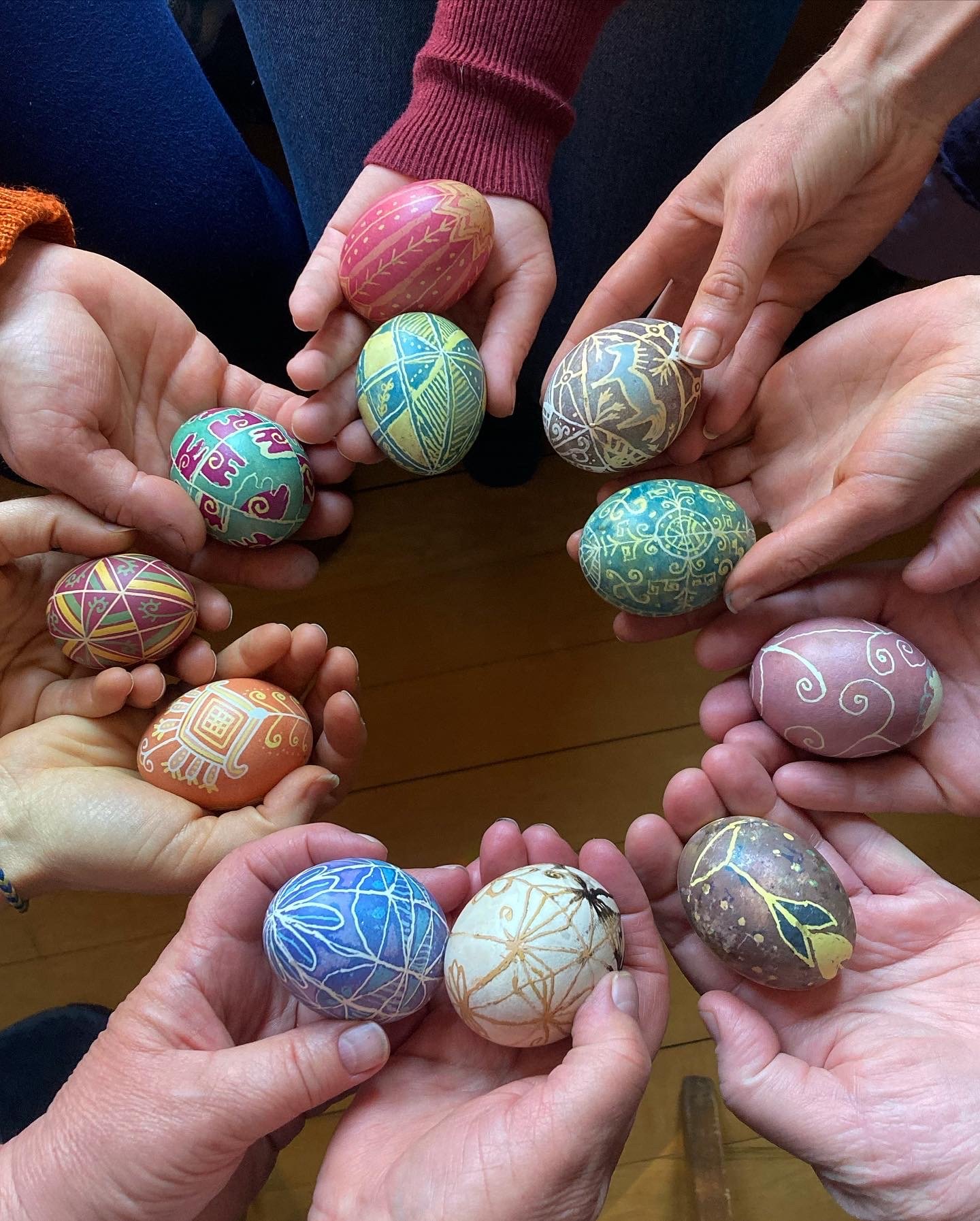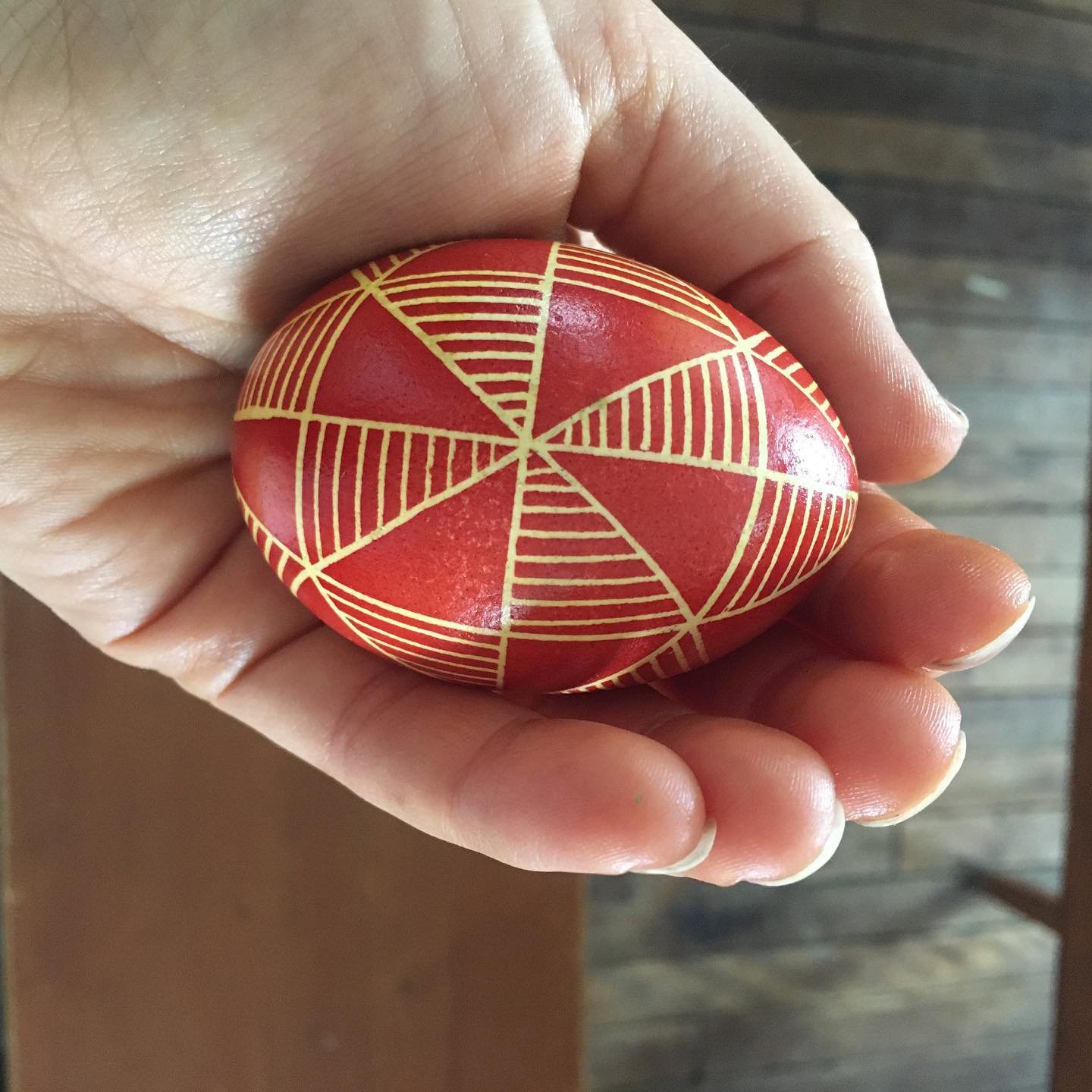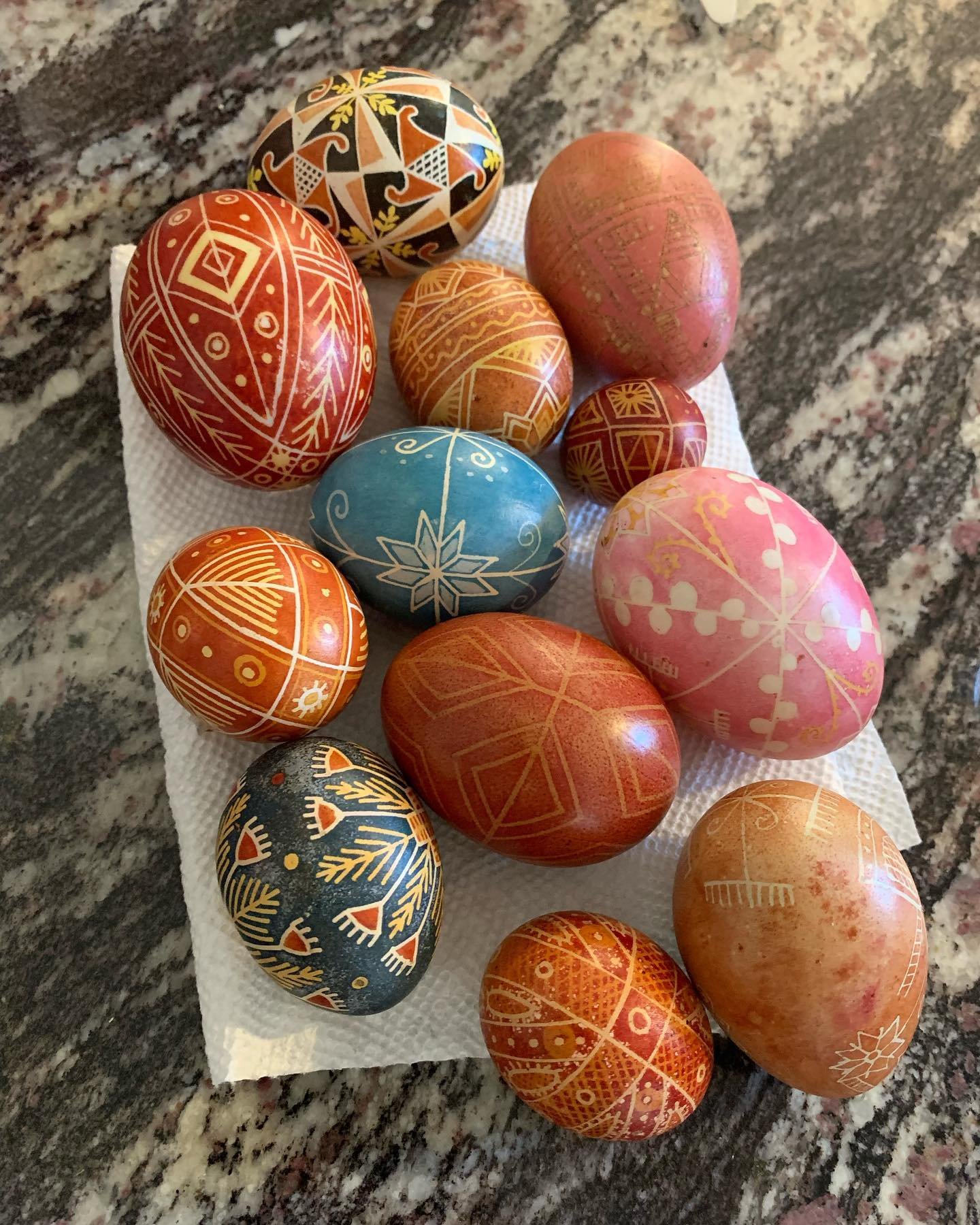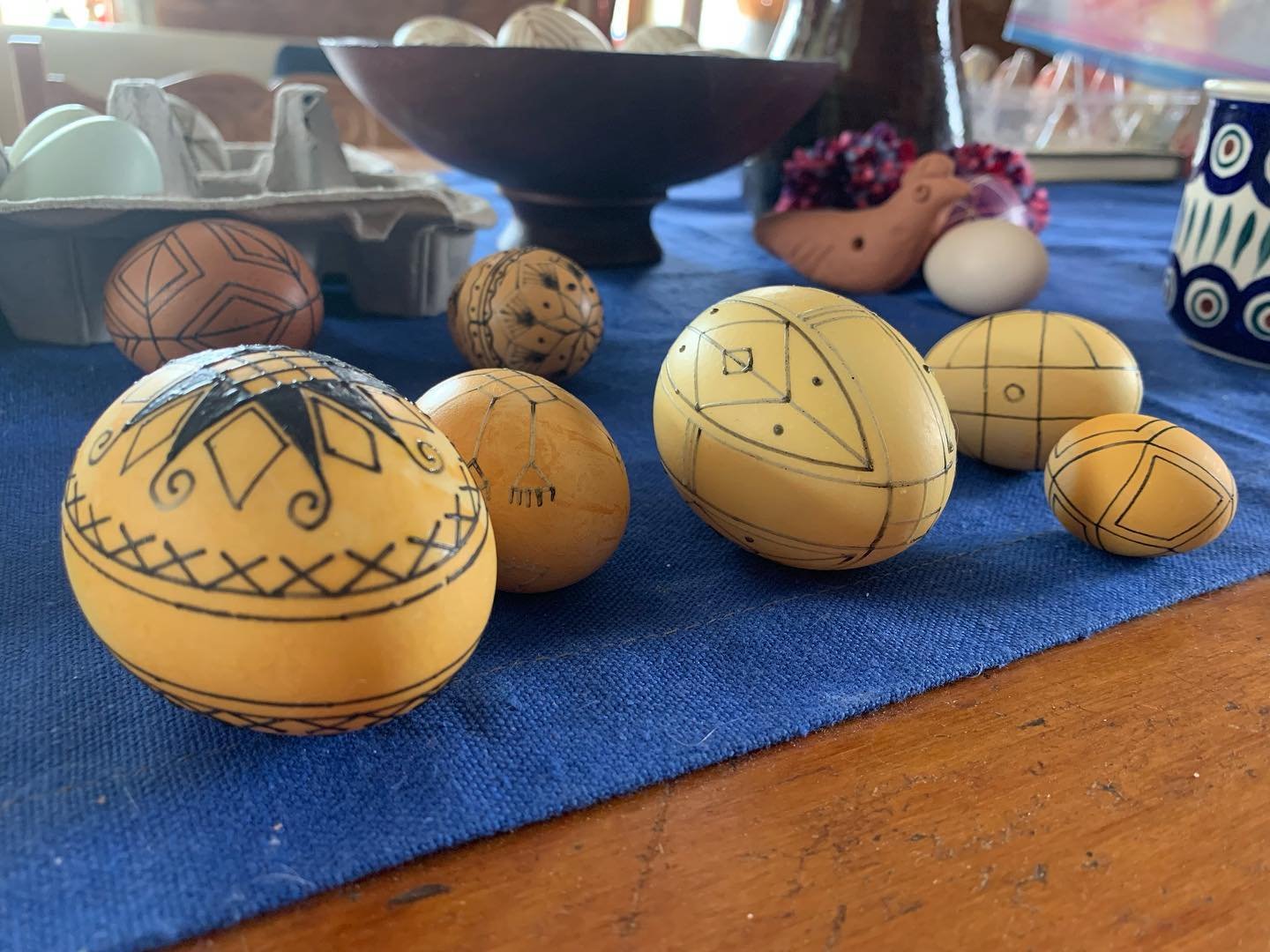PYSANKY RESOURCES & KIT - Making Pysanky Using Natural Dyes
Natural Dyes vs. Aniline Dyes for Pysanky
– A Short Commentary by a Pysankarka
Making pysanky using natural dyes (instead of aniline dyes) involves working with varying materials of different quantities and qualities (some are bulky and light, others are denser, powdered or whole, etc.), which really differs from the ‘quick and dirty’ dumping of a uniform pack of chemical powder into hot water and mixing.There’s a lot more nuance and magic and it’s really a lot cleaner and safer for you and your kin. Aniline dye packets are designed to provide a uniform product each time, and the chemical dye can be used indefinitely. It doesn’t change over time, other than get depleted (it shouldn’t spoil unless it gets contaminated with organic matter, which it can).
In contrast, natural dyes will evolve over time, either deepening or losing strength (depending on the dyestuff and the conditions) and will generally need to be kept cool to keep from spoiling. Sometimes the development, such as fermentation, is desired, and will produce an interesting shade or effect. (When it comes to dumping them, you can just compost them.)
When it comes to making the aniline dyes, you must be very careful, because handling them and breathing in the particles is dangerous (they are considered carcinogenic and one should wear a mask and avoid inhaling the steam). When discarding them, you also realise that now you are responsible for dumping toxic waste back into the earth… hmm, sacred practice but not so sacred then?
This is what has brought us back to the natural dyes– less harm!
But here we also discovered– the full picture of pysanky making, from start to finish. And here we have found more connectedness! –to the world around us, and to our handmade past, our ancestral ways, our land-based lineages.
Back to the matter of the dyestuffs…
Generally, with natural dyes, you will be making a new batch of dyes each time you make a batch of pysanky. It’s not super laborious or tedious, but there’s more presence asked of you, and more reward, in many ways :) It’s a much more co-creative endeavour (you and nature) and I bet once you get into it, you’ll find it to be an integral part of the whole ritual of making pysanky. It is so fun to be involved directly in the alchemy of colour, even if it’s as simple as watching onion skins you saved from countless broths, make a jar of deep gold sunshine on your counter.
Take the time and ground into the joy and serenity of this handmade endeavour.
May you find peace in making pysanky & bring peace to the world,
Bozena Hrycyna 2023
Rainbow created with natural dyestuffs by grade 3/4 class for dyeing their pysanky
1. Our natural dyes pysanky starter kit contains:
Allum (white crystals)
Safflower (reddish petals like saffron) or Turmeric (yellow powder or granules)
Cochineal (purple-ish beetles)
Madder (reddish root of the madder plant)
& a pysanka stylus, cleaning wire, beeswax candle and/or beeswax piece
Bonus: photo card of some traditional pysanky made with natural dyes (for inspiration)
2. What you need
tools for making pysanky (stylus + beeswax)
natural dyes*
allum (a modifier that can be added to dyes to lighten them and also acts as a mordant- helping the dye adhere to the egg)
eggs (hollow or *raw) at room temperature
candle w/ candle holder
matches or lighter
thick paper towel or other absorbent cloth
containers (a wide mouth jar or tupperware container ) w/ lid for dyes
spoons for each dye (big enough to hold an egg)
hot/boiled water
vinegar (for dipping your eggs in to clean them)
scrap paper to test your stylus
newspapers / something to cover the table / to catch dripping wax
inspiration! see beautiful creations posted online or buy a lovely pysanka book from a Ukrainian bookstore #pysanky
* You have the option of blowing out your egg before you make your pysanka. If you do so, you will need to weigh your egg down during the dyeing process. You can use a raw egg and not empty it (as per tradition). It will eventually dry out with sufficient airflow (and away from direct heat).
3. *Natural Dyes
Make sure that you prepare your dyes a few hours before you start your pysanka so that they have time to steep and cool.
Dyes must be at room temperature when you use them.
A few suggestions for natural dyes:
Yellow- turmeric powder or fresh root (chopped up fine)
Yellow- safflower (dried)
Orange/Gold- yellow onion skins (dry outer skins)
Copper- red onion skins (dry outer skins)
Forest Green- nettle leaf (fresh or dried)
Bright Green/Teal- layering a blue over a yellow base (ie. cabbage after safflower)
Fuschia or Violet- cochineal (whole or ground up)
Brick red- madder root*
Berry red- madder & cochineal (50/50 mix of dye)
Blue- purple cabbage leaves (fresh chopped or dried powder) (over a white or light base will give a pure blue)
Purple/Midnight Blue/Black- purple cabbage leaves very concentrated (layered over dark colours will give black) or overdyed with other dark dyes
Simmering cabbage for a minute might help release more juiceBlue-Black- blueberries; elderberries; mulberries (frozen works well)
*Madder root should be brought up to just below simmering *DO NOT BOIL*. Boiling madder will destroy its strength.
Most dyestuffs can also be cold steeped or made through slow decoction over a longer period of time.
For the bulky materials (onion skins, nettle leaf and cabbage) I fill 3/4 of 500ml jar packed full, and for other materials I add about 2 ounces or a teaspoon in 250-300 ml. Using less water will make your dye more concentrated, so if you are just dyeing one egg at a time at home, and wanting to conserve expensive dyestuffs (ie. cochineal), just make a smaller more concentrated batch.
RESOURCES
This is by no means a comprehensive list of all the possibilities.
To make others, you can find lots of comprehensive detailed information on Mar'yana Svarnyk's blog: The Cosmic Egg www.eggbatik.com.
Iryna Mykhalevych in Ukraine (Kropyvnytsi) has done extensive research and dissemination on pysanky making with natural dyes. She has wonderful videos and posts on her youtube channel, blog, facebook page and has published a book in Ukrainian (available at Koota Ooma in Toronto or through their website). She is a wonderful resource!
Also, the sharing in her facebook group School of Pysankarstvo “Ryast” is a great resource!
We highly recommend both these resources! If you want to see photos of what colours can be achieved naturally, they have tons of examples.





